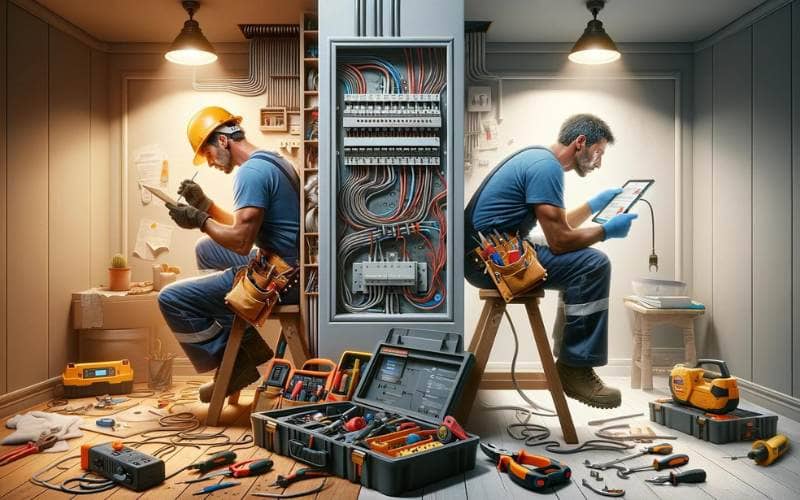A Comprehensive Guide to Electrical Installation Planning for Homes
Written by Total Power Energy Team
Published:
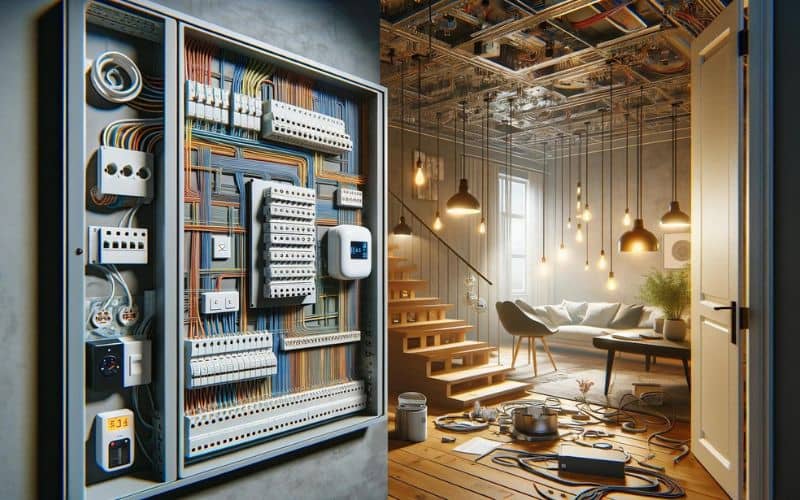
Have you ever found yourself in a situation where you’re about to start on a home improvement project? Adding a new room or renovating an existing one, but you realize you’re clueless about electrical installations? You’re not alone.
Many homeowners face the challenge of understanding and planning electrical systems for their homes. But fear not!
This comprehensive guide will walk you through everything you need about home electrical installation. From the basics to creating a detailed layout and understanding local regulations.
So, let’s dive into this guide !
Understanding the Fundamentals of Electrical Installations

Basic Electrical Concepts
The principles of voltage, current, power, and electrical safety are at the foundation of any electrical system. These concepts are the bedrock upon which a reliable and safe installation is built.
Learning the basics of how electrical wires and circuits function offers a safeguard against the risks of electrical shock and short circuits, protecting your home and loved ones.
Components of a Home Electrical System
A well-designed system comprises several key components: the electrical panel, circuit breakers, wires, outlets, and switches, all orchestrated to distribute power efficiently.
The service panel acts as the heart, with circuit breakers serving as vigilant guardians against overload. Understanding these elements is crucial for any home improvement or DIY electrical project.
Identifying Your Electrical Needs

Inventory Your Appliances and Devices
A comprehensive list of your home appliances and devices sets the stage for effective planning.
This inventory isn’t just about what you currently use but should also consider future additions.
Such foresight ensures your electrical system can adapt to evolving needs without extensive overhauls.
Consider Future Needs
Anticipating future modifications or technological advancements can save considerable time and expense down the line.
Whether it’s potential home office setups or entertainment systems, planning for tomorrow’s needs today is a hallmark of wise electrical installation planning.
Consult a Qualified Electrician
Despite the temptation of DIY home improvement, certain aspects of electrical work demand professional expertise.
A licensed electrician can offer invaluable insights and guidance, ensuring your plans align with safety standards and regulatory requirements.
Planning Your Electrical Installation
Assessing Your Needs Room by Room
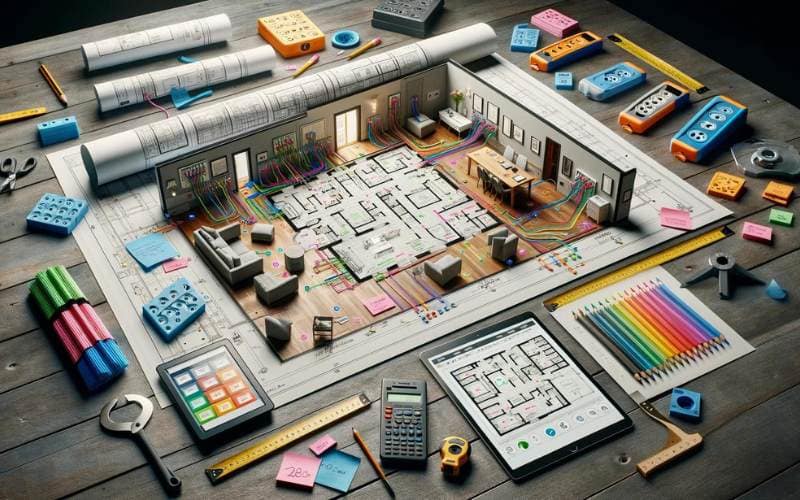
Room-Specific Requirements: Exploring what each room needs helps figure out exactly what electrical stuff it requires—like how many outlets and where to put light switches.
Kitchens and laundry rooms might need special circuits. Planning all this out now helps avoid problems later and improves everything.
Special Considerations: Bathrooms and kitchens need special outlets called GFCI to stop electric shocks.
But living rooms and bedrooms might have different kinds of lights and outlets based on their use. Knowing these differences keeps your home safe and comfy.
Determining Load Capacity
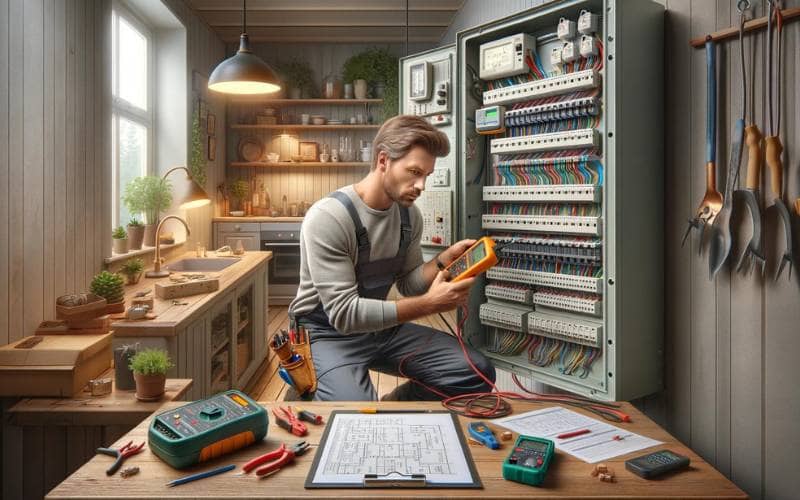
Understanding Electrical Load: It’s really important to know how much electricity your home uses to avoid overloading circuits.
To do this, figure out how much power your appliances and devices need in terms of amps and watts.
This helps ensure each circuit can manage its workload properly, keeping things running smoothly and safely.
Load Calculation Resources: If you’re dealing with a complicated electrical setup or have powerful appliances at home, it’s best to get help from a qualified electrician.
They can calculate precisely to ensure everything is safe and meets the rules. It’s really important for keeping your home safe and following the law.
Creating a Detailed Layout
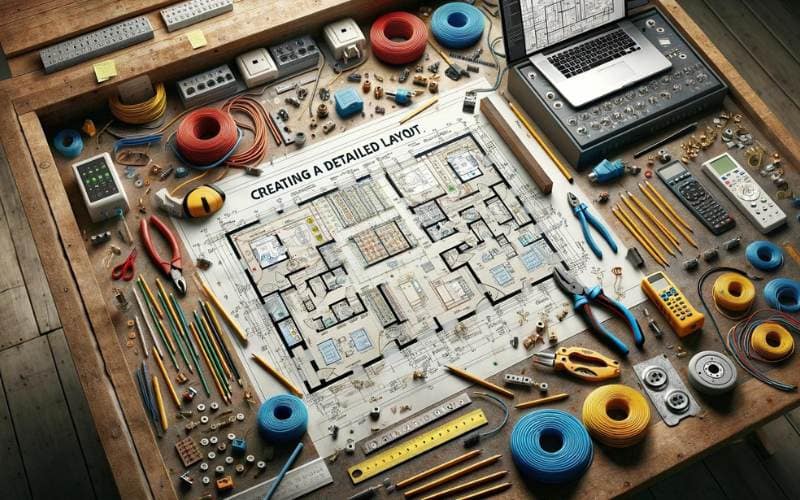
It helps ensure everything is in the right spot for convenience and works well.
Compliance with Building Codes: Following local building codes and NEC regulations is essential.
These rules cover everything from how far apart outlets should be to the height of switches and the need for grounding. They’re there to make sure your electrical work is safe and legal.
Understanding Local Building Codes and Regulations

Research Local Regulations
Following local building codes and NEC regulations is essential.
These rules cover everything from how far apart outlets should be to the height of switches and the need for grounding.
They’re there to make sure your electrical work is safe and legal.
Compliance is Essential
Following these codes guarantees the safety of your electrical installation and protects you from potential legal and financial liabilities.
Ensuring compliance with these regulations is critical in safeguarding your investment and maintaining the integrity of your home’s electrical system.
Essential Materials for Electrical Installation

- Safety First: Prioritize using high-quality electrical materials that meet safety standards and are approved for use in your region.
- Wires and Cables: Choose the appropriate wires and cables for your installation needs, considering factors such as wire gauge and insulation type.
- Outlets and Switches: Select outlets and switches compatible with your electrical system and meet your functional requirements.
- future.
Check Out this Article :Cost To Install Electrical Outlet Outside In 2024
- Circuit Breakers: Install circuit breakers to protect your electrical circuits from overloads and short circuits.
- Grounding System: Ensure proper grounding to protect against electrical shocks and provide a safe path for electrical currents.
- Conduit: Use conduit to protect and route electrical wires, especially in areas where they may be exposed to physical damage.
- Electrical Boxes: Install electrical boxes to safely contain wiring connections and provide mounting points for outlets, switches, and fixtures.
- Wire Connectors: Use wire connectors to securely join electrical wires and prevent loose connections that could lead to safety hazards.
- Testing Equipment: Have testing equipment on hand to verify proper installation and troubleshoot any issues that may arise.
- Labels and Markers: Label electrical components and circuits for easy identification and maintenance in the
Hiring a Professional vs. DIY
While the allure of DIY projects can be strong, electrical work requires expertise and knowledge that goes beyond the average homeowner’s skill set.
Safety is Paramount
The potential risks associated with electrical installation—from electrical shock to fire hazards—underscore the importance of entrusting this work to professionals.
A qualified electrician has the training and experience to ensure your electrical system is installed safely and correctly.
When to Hire a Professional
There are several scenarios where professional expertise is not just recommended but necessary. These include:
- Complex installations involve the main service panel, subpanels, or extensive wiring.
- Renovations that require significant updates to your home’s electrical system.
- Projects in older homes where the existing wiring may not meet current safety standards.
- Any situation where you’re unsure of your ability to safely complete the electrical work.
Conclusion
Electrical installation planning is crucial for creating a safe, efficient, and comfortable home. Understand the basics, carefully assess your needs, and adhere to building codes and regulations.
That way, your home will have the perfect electrical system for now and in the future. Whether you get help from an electrician or do some of it yourself, it’s important to be careful, know what you’re doing, and understand the risks.
If you’re at the start of your home improvement journey or looking to upgrade your existing electrical system, consulting with a professional can save you time money, and ensure your home’s safety and efficiency. Don’t hesitate to contact Total Power Electric for expert electrical installation services for your home’s electrical needs.
Total Power energy content Team
Total Power Energy content team provide valuable tips and guidance on electrical information.
Our writers are experienced in the electrical field and produce high-quality content such as electrical safety, installation, repair, etc.
Our goal? To help you work safely and smartly. Our advice is easy to follow whether you’re at home or on the job. Stay safe and confident with our help!

